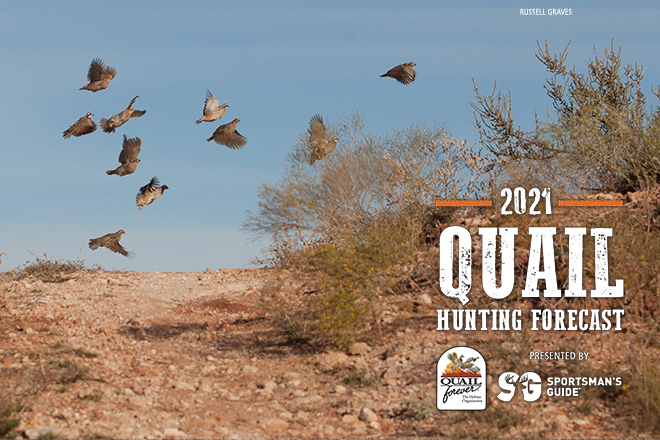 By Greg Breining
By Greg Breining
“Better than last year, but last year was pretty marginal,” says Ed Gorman of the upcoming quail season in Colorado.“I would say it’s below average is a good way to characterize it.” Gorman is small game manager for Colorado Parks and Wildlife. He blames weather for the poor forecast.
Weather
“The drought of 2020 really hampered quail. We had some rain in May but then we had almost nothing again in June and July, so it really slowed things down as far as production.” Drought translates to loss of food for chicks and poor quality cover. “We’re missing the right timing on moisture, because they’re kind of suppressed right now.” Furthermore, a severe cold snap in northeastern Colorado in February—“a little bit of snow and a whole lot of cold” with daytime highs of minus 30—killed a lot of birds, says Gorman. “We had some radio-marked quail that all perished in that storm.”
Colorado has hunting for bobwhite, scaled, and Gambel’s quail. Bobwhite are found in sage rangeland or cottonwood riparian areas on the eastern plains, says Gorman. Scaled live in southeastern Colorado. And a few Gambel’s are scattered through western Colorado, often in settled areas—“not a ton of hunting opportunity,” says Gorman. Most hunting is for bobwhite and scaled.
Habitat, Broods, and Counts
Colorado doesn’t officially collect roadside data on quail broods. By late summer, there’s little dew to push birds to roadsides where they can be seen. “You track the weather you get a real good idea, and follow that up on the ground talking to people,” says Gorman. “It sounds to me that some of the bobwhite in the southeast will probably be OK hunting. It’s not going to be like it was five years ago when they were literally everywhere. They’re going to be tied into the better habitat now, which is what you’d expect,” says Gorman.
Drought has affected even the arid-country scaled quail. “You wouldn’t think it affects scaled quail like it does, but it certainly does here,” says Gorman. “It certainly can be too dry for scaled quail.”
Top Spots
Gorman recommends hunters try Baca County in the southeast corner of the state. “That’s where I would go,” he says. “That’s kind of a unique area where within a morning hunt you can bobwhites, scaled quail, and pheasants. Occasionally you’ll find two or three in the same field.” Best of all for hunters without local connections, there’s plenty of access, largely because of the Walk-In Access program. “Some of the best habitat down there we have leased,” he says.
The Comanche National Grassland also offers plenty of acreage to hunt for quail. Look for sand sagebrush near cropland, especially if grazing has opened up the sage for patches of seed-producing annuals. Says Gorman, “In a good year the quail hunting can be fabulous down there. In an average year, it’s OK.”
Despite the killer cold in the northeast last winter, hunters should find bobwhite in the South Platte River corridor from Fort Morgan east to the state line. “The population appears to be suppressed but I did see a really nice covey,” Gorman says. “There’s a ton of access. There lots of state wildlife areas along that stretch of the river.”
Insider Tip
When hunting scaled quail, look for old “guzzlers” (drinking catchments for wildlife) and relics from abandoned homesteads. “Anything out there on the prairie that’s out of place, even if it’s artificial, is a good place to look for scaled quail,” says Gorman. “Junked out car bodies, old combines—I can’t list all the places I’ve shot scaled quail over the years.”
If You Go
Season 1: Nov. 13–Jan. 31, 2022, east of I-25 and south of I-70 from I-25 to Byers and Highway 36 from Byers to Kansas, and the parts of the following counties that are west of I-25: Pueblo, Fremont, Huerfano, El Paso and Las Animas.
Season 2: Nov. 13–Jan. 2, 2022, east of I-25 and north of I-70 from I-25 east to Byers and Highway 36 from Byers to Kansas.
Season 3: Nov. 13–Jan. 2, 2022, west of I-25 except those areas west of I-25 in Pueblo, Fremont, Huerfano, El Paso and Las Animas counties.
Limit is 8 of each species daily and 24 of each species in possession.